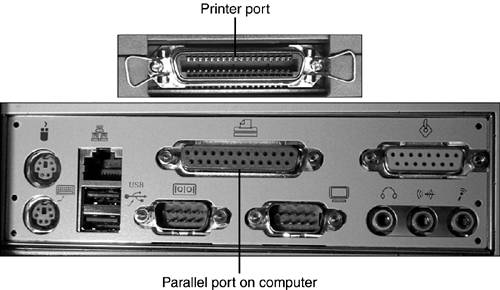

Download a newer version of the printer drivers if available and print another test page from a document if you are not satisfied with the output.

Click the "Print a Test Page" button on the final confirmation screen and click "Finish" if you are satisfied.
#Parallel port driver#
Wait a few moments for the printer driver to install. Click "Next." Locate the make and model of your printer using the "Manufacturer" and "Printer" menus in the dialog box that appears, or insert your driver disk and click "Have Disk" before you click "Next." Select the "Use an Existing Port" radio button and choose "LPT1" in the pull-down menu if it is not already selected as the default option.

Click "Add a Local Printer" in the Add Printer dialog box that appears when you click "Add a Printer." Click "Add a Printer" at the top left of the "Devices and Printers" window. Select "Devices and Printers" in the Windows Start menu.
#Parallel port for mac#
Go on to Step 4 for Windows or Step 7 for Mac if you are not satisfied with the print output or if nothing printed. Use the printer as you normally would if the quality of your test sheet is satisfactory. Open any word processor document and print it on your parallel printer by selecting that device in your list of printing options. Skip to Step 4 for Windows or Step 6 for Mac if you do not see the printer on your list of devices. Wait a minute or so for a message confirming that the printer has been detected, or check your "Devices and Printers" panel via the Start menu in Windows (or your "Finder" panel via the dock in OS X) to see if the printer is listed by name or as a generic printer. Please Log in or Create an account to join the conversation.Plug the USB end of the cable into any open USB port on your computer. ParPort Base Address: e010 (I also tried 0xe010) Memory at f7d00000 (32-bit, non-prefetchable) Memory at f7d01000 (32-bit, non-prefetchable) PCIe 9912 Multi-I/O Controller (prog-if 03 ) Parallel Port Card: PCI-e x1 Card: SY-PEX10008 (others have apparently used this successfuly with LinuxCNC):Ġ2:00.2 Parallel controller: MosChip Semiconductor Technology Ltd. I've included as much additional information as possible, so I can at least claim to be a good question-asker. I fear my question may be very naive, so please forgive my ignorance. I also tried the Parallel Port Tester (ptest.hal), and got the same result. My first test is showing +5VDC (more like +4, really) coming off the output pins no matter what I am doing (measuring with a multimeter: negative to pin 24, positive to pin 3). I have a C83-Optoisolator Board on the way from CNC4PC, but for now, my intent is to just get LinuxCNC outputting a measurable step/direction signal through the StepConf "Axis Test" feature. I am now attempting to get LinuxCNC to work as the motion controller. I have tested the output signal from Windows and am getting a 0VDC and +5VDC signal when I toggle pins using a parallel port tester program.
#Parallel port windows 10#
I have a dual boot Windows 10 / Debian system. I'm on something of a schedule, so I'd like to start by keeping things dirt simple, and add complexity later if I find I need it.

After some fussing and a bit of tuning, I've managed to run all three axes from a Teensy 3.6 running the TeensyStep library just to make sure the encoders and drives all work. I intend to use the original DG2S-08020 Servo Drives (). I am "renovating" an old Precix CNC to run off of LinuxCNC. I am hesitant to post, as I'm sure my question is quite remedial, but I am at a loss.


 0 kommentar(er)
0 kommentar(er)
